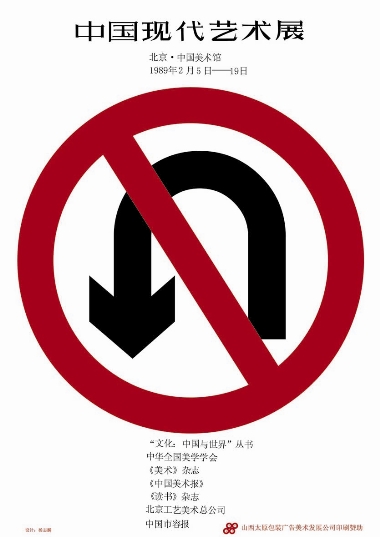|

Newman Huo
SHANGHAI calendar paintings, political posters from the Cultural Revolution period, and modern commercial posters are highlights of an exhibition, “Chinese Graphic Design in the 20th Century: A Documentary” at the Guan Shanyue Art Museum until Feb. 27.
Featuring posters, magazines and newspapers from the 20th century, the exhibition is a comprehensive presentation and interpretation of the dramatic development of modern Chinese graphic design development.
“Chinese graphic design in the 20th century is actually a very broad concept and its development has reflected the complicated transformation process of social, political, economic and cultural lives in China over the past century,” said Huang Zhicheng, director of the research department at Guan Shanyue Art Museum and the exhibition’s assistant curator.
“We’ve chosen Chinese posters as a representative form of modern Chinese graphic design to show the interrelation between Chinese posters and social change in several major historic periods during the past century,” Huang said.
The exhibition’s first part, “Republic and Life,” focuses on calendar paintings, magazines and newspapers from the 1920s and 30s.
Calendar paintings, a unique form of advertising, first appeared in the 22nd year (1896) of Emperor Guangxu of the Qing Dynasty. That year a draft bank in Shanghai called Hongfulai issued a lottery ticket entitled “Colorful Scenes of Shanghai: Chinese and Western Calendar.” The lottery ticket was decorated with a traditional Chinese painting and calendar.
The main subject of calendar paintings was ancient Chinese beauties, such as Xi Shi, Wang Zhaojun, and Diao Chan, and well-known actresses of the early years of the Republic of China, such as Ruan Lingyu, Hu Die and Lu Meiyu.
The typical images of beautiful women in cheongsams depicted in the calendar paintings became a significant feature of commercial advertising in the period of the Republic of China (1912-1949).
In addiction to the calendar paintings, more than 30 old magazines from the period of the Republic of China are also an attraction. Most of the magazines were designed by celebrated Chinese scholars, such as Qian Juntao, Ye Qianyu, and Feng Zikai, and represented the highest level of Chinese graphic design at the time.
The exhibition’s second part, “People and Heroes,” presents more than 100 political posters produced from 1950s through the early 1980s.
After the founding of the People’s Republic of China, many artists became involved in the creation of political posters, one of the methods of mass publicity.
There are also political posters produced by celebrated painters, such as Yan Han, Zhang Daoyi, Liu Bingli and Ha Qiongwen. These posters were strongly influenced by the then Soviet style.
Among political posters between 1960s and 1970s, posters produced in Guangdong Province were special, according to assistant curator Huang.
“This was because the China Import and Export Fair, then popularly known as the Canton Fair, was the only window through which the country communicated with the outside world during the Cultural Revolution,” Huang said.
“Different from posters produced in other regions, posters from Guangdong were less political, but had more lyrical elements with such a theme, ‘welcoming friends from all over the world,’” Huang said.
The exhibition’s third part, “Citizens and Today,” features more than 100 commercial posters produced after the 1980s.
Graphic design in China took on a new face as the country began to implement economic reform and open door policies in the 1980s.
Graphic designers on the mainland, along with those from Hong Kong, Macau and Taiwan, began to produce commercial posters.
Designers from Shenzhen stand out on the contemporary Chinese graphic design scene. Among the more than 100 commercial posters on display in the third part, more than 40 were produced by Shenzhen designers.
The exhibition is organized by the Guan Shanyue Art Museum and the Central Academy of Fine Arts in Beijing. It was previously shown as a part of the World Design Congress in October, 2009, in Beijing.
Dates: Until Feb. 27
Hours: 9 a.m.-5 p.m. Closed Monday
Venue: Guan Shanyue Art Museum (关山月美术馆)
Add: 6026 Hongli Road, Futian District (福田区红荔路6026号)
Buses: 10, 14, 25, 34, 105, 111, 215, 228, 238, 322, 350, 371
Metro: Shao Nina Gong Station (Children’s Palace Station, 少年宫站), Exit B
(From above)
Commercial poster “1989 China Modern Art Exhibit” by Yang Zhilin in 1989.
Commercial poster “Graphic Design in China” by Chen Shaohua in 1992.
(L) A calendar painting for a Shanghai battery company in the 1930s.
(C) A political poster from the Cultural Revolution period.
A calendar painting for a Shanghai cosmetics company in 1937.
(L) A political poster from the Cultural Revolution period.
Commercial poster, “Idea,” by Xin Diqiang in 1993.
Photos by Huo Chengju
|

